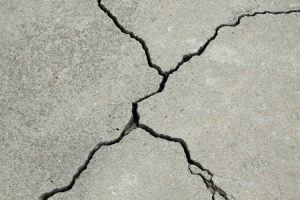
Concrete is renowned for its strength and durability, but it’s not immune to the natural forces that can lead to cracks over time. Whether it’s due to temperature fluctuations, settling, or the passage of years, concrete cracks are a common issue for many homeowners.
Understanding the Types of Concrete Cracks
Before we discuss when to seek repairs, it’s important to understand the different types of concrete cracks:
- Hairline Cracks: These are very thin cracks that are typically less than 1/8 inch wide. While they may not pose an immediate structural threat, they can allow moisture to penetrate the concrete, potentially leading to more significant issues over time.
- Shrinkage Cracks: As concrete cures, it undergoes a drying and shrinking process. Shrinkage cracks are small, random cracks that occur during this natural curing process. They are usually not a cause for concern unless they become extensive.
- Settlement Cracks: These cracks occur when the ground beneath the concrete shifts or settles. They can be more significant and may require attention if they affect the structural integrity of the concrete.
- Expansion Cracks: Expansion cracks happen when concrete expands due to temperature changes, moisture, or other factors. These cracks often appear as long, straight lines.
- Structural Cracks: Structural cracks are the most concerning and typically indicate a significant issue with the concrete’s strength or stability. They can be caused by factors like heavy loads, inadequate reinforcement, or foundation issues.
When to Seek Repairs
- Width and Depth: The width and depth of a crack are essential factors in determining the need for repair. Generally, cracks wider than 1/8 inch and deeper than 1/2 inch should be inspected by a professional.
- Location: The location of the crack also matters. Cracks in critical areas, such as load-bearing walls, foundations, or structural elements, should be addressed promptly.
- Progression: Monitor the progression of cracks. If a crack continues to widen or lengthen over time, it indicates an ongoing issue that should be assessed and repaired.
- Safety Concerns: Cracks that pose safety hazards, such as tripping hazards on sidewalks or driveways, should be repaired promptly to prevent accidents.
- Water Infiltration: If cracks allow water to penetrate the concrete, it can weaken the structure and lead to further damage, including freeze-thaw damage in cold climates.
The Repair Process
The repair process for concrete cracks can vary depending on their type and severity. Small, hairline cracks may only require filling with a concrete crack filler or sealant. More extensive cracks may necessitate the removal of damaged sections and the pouring of new concrete. In cases of structural cracks, it’s essential to consult with a professional to assess the extent of the damage and determine the appropriate repair method.
Contact Templin Concrete Construction at 612-388-1945 today or visit us online for more information about advice on how to repair concrete cracks, or look into our concrete construction services.






